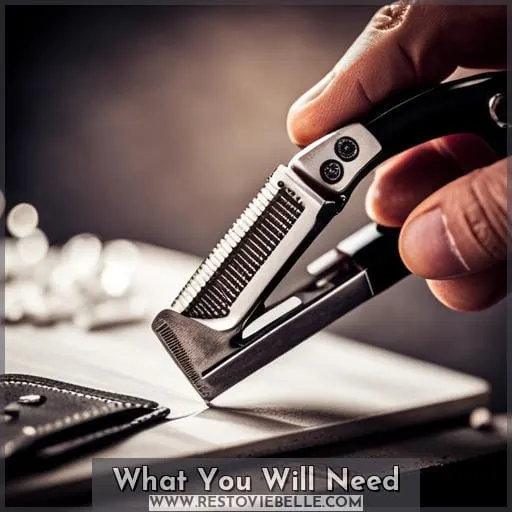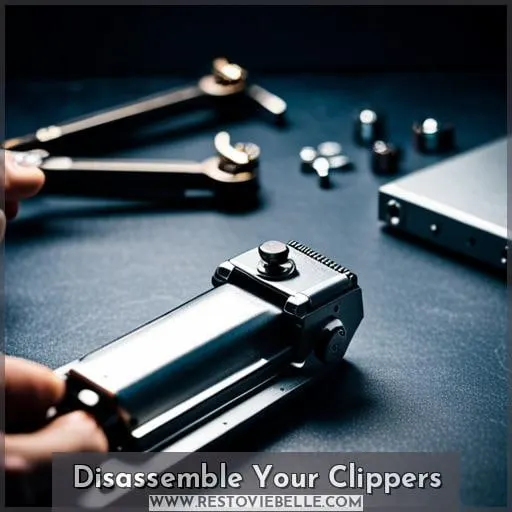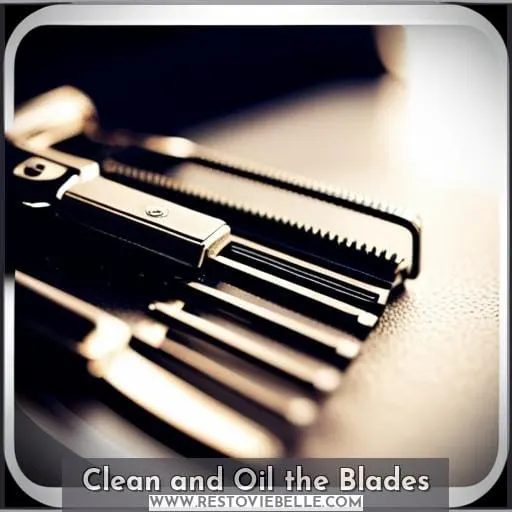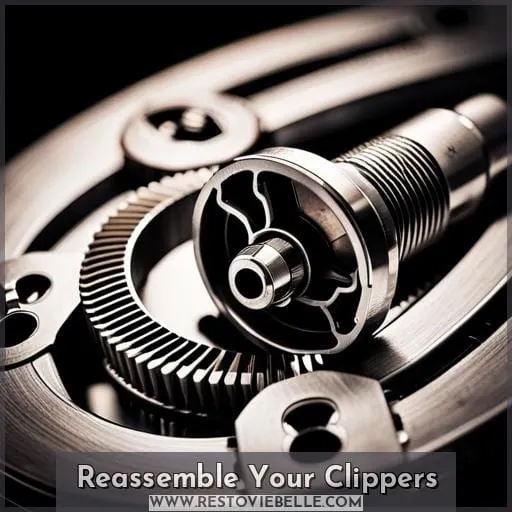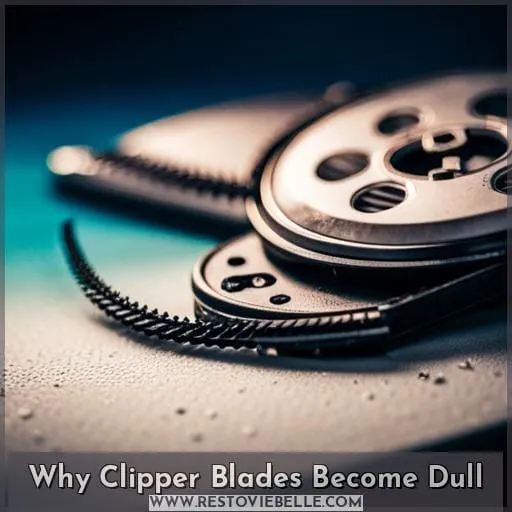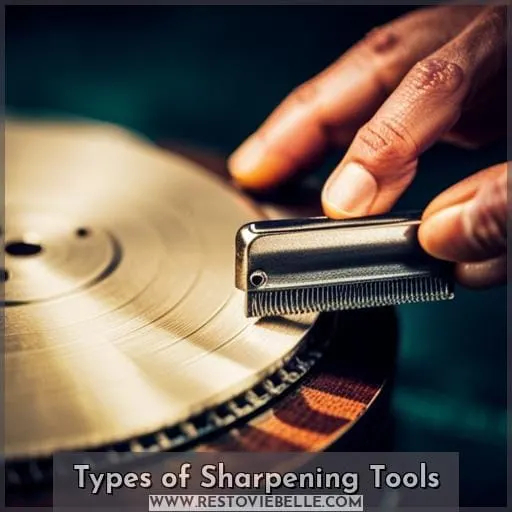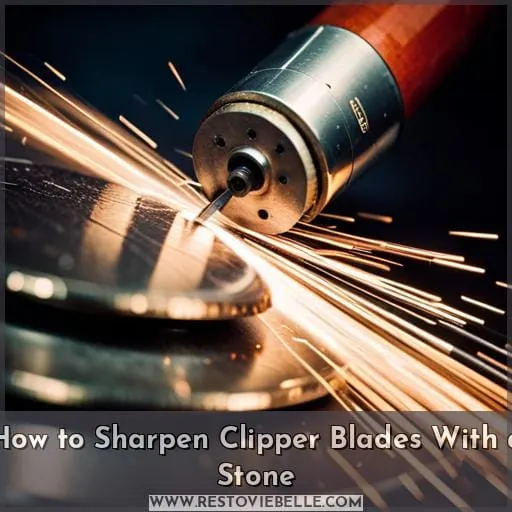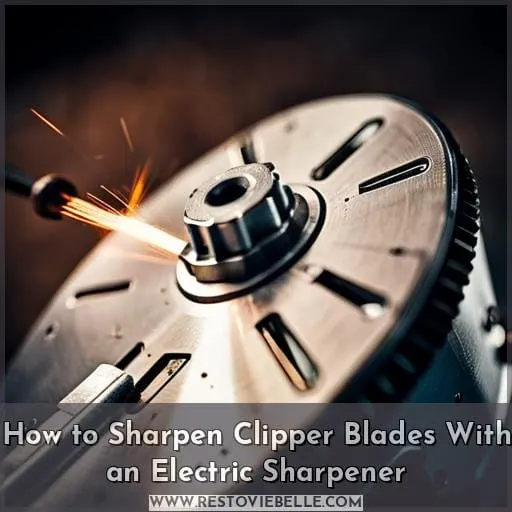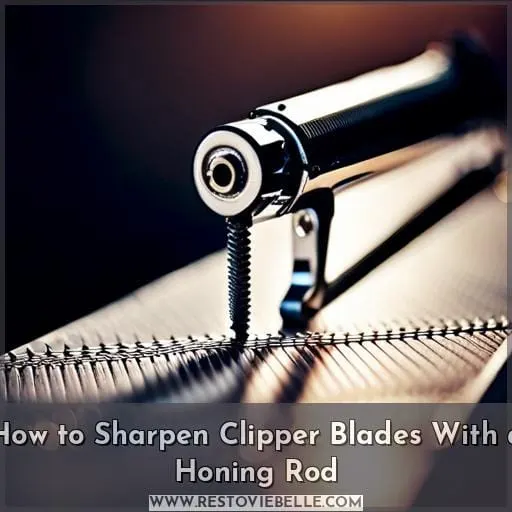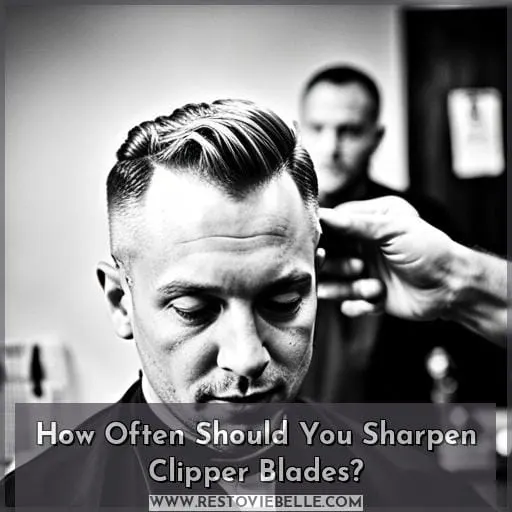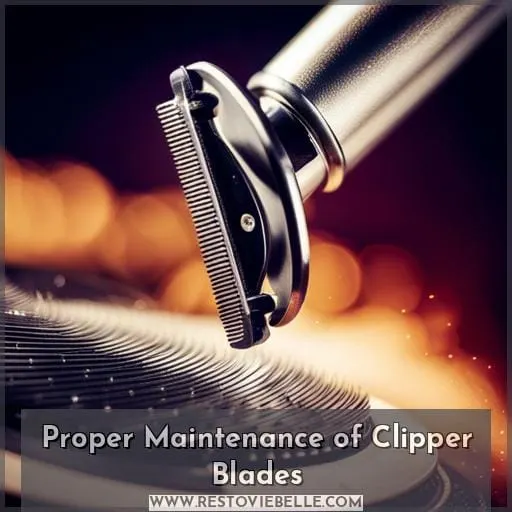This site is supported by our readers. We may earn a commission, at no cost to you, if you purchase through links.
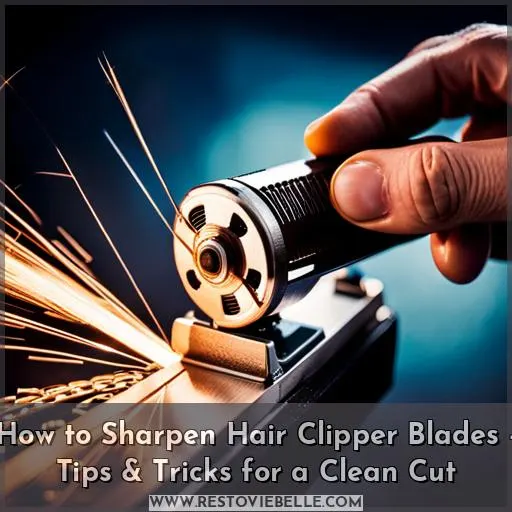 Navigating the world of hair care can be a daunting task, but it doesn’t have to be. Like any skill, sharpening your clipper blades is something you can learn and master with time and effort.
Navigating the world of hair care can be a daunting task, but it doesn’t have to be. Like any skill, sharpening your clipper blades is something you can learn and master with time and effort.
To help get you started on that journey towards mastering how to sharpen hair clipper blades like a professional barber or stylist, we’ve put together this guide full of tips and tricks for getting clean cuts every time.
From disassembling your clippers to using various sharpening tools such as stones or electric sharpeners – each step in the process is detailed here so you’ll know exactly what needs to be done when it comes time to give those dull blades an extra edge!
Table Of Contents
- Key Takeaways
- What You Will Need
- Disassemble Your Clippers
- Clean and Oil the Blades
- Reassemble Your Clippers
- Why Clipper Blades Become Dull
- Types of Sharpening Tools
- How to Sharpen Clipper Blades With a Stone
- How to Sharpen Clipper Blades With an Electric Sharpener
- How to Sharpen Clipper Blades With a Honing Rod
- How Often Should You Sharpen Clipper Blades?
- Proper Maintenance of Clipper Blades
- Frequently Asked Questions (FAQs)
- How should I store my clipper blades?
- Are there any safety precautions I should take when sharpening clipper blades?
- How do I know when my clipper blades need to be sharpened?
- Are there any alternatives to sharpening clipper blades?
- Are there any special techniques to use when sharpening clipper blades?
- Conclusion
Key Takeaways
- Sharpening clipper blades enhances cutting performance.
- Proper maintenance between sharpenings is crucial.
- Regular cleaning and oiling of blades is necessary for optimal performance.
- Recognizing dull blades is important to ensure effective trimming.
What You Will Need
You’ll need the right tools to get your clippers back up and running smoothly for perfect cuts every time. A handheld sharpener with a file or sharpening stone attached to it is an affordable option, but electric sharpeners are faster and may last longer.
For proper maintenance between sharpenings, use correct clipper blade oil on clean blades after each use. This will help extend their life as well as save money by reducing how often they need professional service.
Disassemble Your Clippers
Now that you have all the tools needed to sharpen your hair clipper blades, it’s time to begin the disassembly process. Before doing so, make sure to clean and oil your blade with a few drops of clipper oil before removing any screws.
With a Phillips screwdriver in hand, take off the metal plate which holds together its two halves – exposing each side of the blade. Carefully remove both sides from their housing by gently pulling them apart without bending or damaging them in any way.
Be mindful not to lose small parts such as pins and screws during this process as they are crucial for reassembling later on when sharpening techniques are done.
Once removed, use a cloth or towel dampened with warm water and soap solution if necessary for further cleaning before applying sharpening products like stone files or electric sharpeners onto each side of the blade evenly until desired results are achieved.
Use short strokes in a back-and-forth motion while avoiding oversharping, which may damage blades permanently and require replacement instead.
After completing these steps, dry off excess moisture thoroughly, then lightly apply a fresh layer of clipper oil into both sides prior to putting everything back together again.
With proper care and maintenance followed up periodically by regular sharpening sessions, you’ll be able to extend the lifespan of your blades significantly while saving yourself money in the long run.
Clean and Oil the Blades
After disassembling your clippers, it’s time to give the blades a thorough scrub and lubricate them with oil for an effortless trim – like buttering toast! Cleaning and oiling your hair clipper blades is just as essential as sharpening them.
To ensure proper maintenance of the product, you should:
- Select a quality blade or clipper oil that won’t damage the metal over time.
- Determine cleaning frequency based on how often you use your trimmer. If used daily, then clean weekly. If used occasionally, aim for once every two weeks.
- Align the blade edges properly after each cleaning session using either Arkansas stone or electric sharpener according to the manufacturer’s user manual instructions about blade alignment/sharpening frequency.
Cleaning and properly lubricating are key steps in keeping these tools functioning optimally while minimizing maintenance costs associated with replacing dulled-out parts prematurely due to lack of care.
Reassemble Your Clippers
Finally, carefully reassemble your clippers to ensure a smooth and even trim. Start by replacing the guide combs and any other attachments onto the blades. Use blade oil to lubricate them before putting them back into position on the body of your clipper.
Make sure that you screw them in tightly so they are secure during use. Otherwise, it can lead to uneven cutting or dulling of blades too quickly due to friction caused by movement in between uses.
Blade Oiling:
- Lubricates Blades
- Prevents Dullness from Friction
Blade Cleaning:
- Removes Grime & Debris
- Prevents Uneven Cuts
Cutting Hair:
- Smooth Trim
Next, make sure all screws are tightened securely when attaching the handle back onto its baseplate.
Lastly, check each part is functioning correctly. Switch on your clipper with no attachments attached first, then add one at a time until everything works as expected again before beginning hair-cutting tasks.
Why Clipper Blades Become Dull
Without proper care, your trusty clipper blades become a distant memory faster than you can say ouch! Dulling of clipper blades is an inevitable process caused by wear and tear from cutting hair, metal fatigue due to frequent use, and built-up hair residue.
To extend blade life, it’s important to oil the cutting blade after every use as well as sharpen them using correct tools like honing rods or electric sharpeners. Nevertheless, professional sharpening services are available for those who wish not to take on this tedious task themselves.
Alignment of the blades also plays a vital role in their performance. Blades need regular realigning with either handheld or electric sharpener devices which help keep edges aligned during the dulling process so that replacement isn’t necessary too often.
However, if alignment doesn’t improve, then new replacements will be needed soon enough regardless of how frequently they’re being maintained otherwise.
In order for any type of maintenance done on these clipper blades – whether it’s regular cleaning or sharpening – make sure that the right kind of tools are used, such as a honing rod when alignments need adjustment and appropriate oils when lubrication is required, in order to get maximum benefit out of them before needing costly replacements down the line.
Types of Sharpening Tools
When it comes to sharpening your clipper blades, you have a few options. Handheld sharpeners are an affordable option and usually consist of a sharpening stone or file attached to a handle. Electric sharpeners are quicker and more expensive, but they provide automated sharpening, which makes them last longer.
Japanese Water Stones, Bench Stones, and Diamond Stones can all be used with the handheld as well as electric sharpeners for optimal results. For realigning blade edges, there is also the honing rod – another steel tool compatible with both types of sharpeners that helps adjust any misalignment in the cutting edge while preserving its original shape without taking away too much material from it like other tools would do.
Oster Fast Feeds use special self-sharpening blades, so no additional tools may be needed at all if proper oiling is followed regularly to maintain their condition.
How to Sharpen Clipper Blades With a Stone
To effectively sharpen your hair clipper blades, you must first unscrew and remove them from the handle. Then, thoroughly clean both sides with a damp cloth or brush to ensure optimal sharpening results.
Dry off and inspect the blades for any burrs or nicks before preparing your stones for sharpening. Use back-and-forth motions on each side of the blade to achieve an even edge. Finally, check that all angles have been sufficiently honed by testing their smoothness against one another.
Unscrew and Remove Your Clipper Blades
Unscrew your clipper and remove the blades to start sharpening. Prepare them by oiling each side, then clean off any residue for a perfect cut. Pay special attention to the interior sides of the blades where dirt and debris can easily build up – this is also an important step in maintaining blade alignment.
For professional results, make sure to highlight both sides of the blade when sharpening using techniques like back-and-forth motions or honing rods.
Clean Your Clipper Blades
Before sharpening, it is important to thoroughly clean your clipper blades for the best results. Use a cleaning brush and blade oils to ensure all hair is removed from the blades. Wash with warm soapy water, then dry completely before applying oil and realigning the edge of each blade using a sharpening stone or honing rod.
Dry and Test Your Blades
Once you’ve wiped and oiled your clipper blades, it’s time to wave goodbye to any dullness – give them a quick spritz of dry shampoo for extra shine! Now that the blade is clean and well-prepped, use a sharpening stone in a back-and-forth motion.
Be sure to test the bottom blade too – this will ensure even edge realignment and a clean, precise cut every time.
- Apply blade oiling before each use
- Sharpen regularly with a stone or professional service
- Clean regularly for optimal performance. With this advice, you’ll be able to masterfully sharpen those clippers!
Prepare Your Blades and Sharpening Stone
Gently position the blades on your sharpening stone and get ready to bring a perfect edge back to life. Lubricate with oil, maintain the honing angle while using a sharpening motion. Adjust the blade angle for better contact with the grit of the stone.
Test sharpness and repeat if needed. Clean the blades after each use by rinsing them in warm water, then lubricate them with clipper blade oil before storage or the next use.
Sharpen Both Your Blades
Hold the blades securely in place and guide them along the sharpening stone, carefully stroking each side until they’re as sharp as you need.
To restore their original sharpness, move your combing blade across the edges of both clipper blades using honing rods and professional-level techniques to achieve a smooth finish.
For an extra fast and efficient result, consider electric or tutorial video sharpeners. If not for convenience, then for a more precise professional finish with minimal effort.
Maintaining regular care by cleaning after every use with quality clipper oil will help keep your blades at peak performance over time without needing frequent re-sharpening.
How to Sharpen Clipper Blades With an Electric Sharpener
Position your clipper blades in the electric sharpener, then switch it on to get a quickly sharpened edge. To ensure a precise cut, make sure you properly align the blade and adjust any settings accordingly.
The magnet handle helps keep them secure while they sharpen at faster speeds than other methods.
Keeping an eye on oil types is also important for successful hair trimmer blade sharpening as too much can cause slippage during use and affect the finish of cuts made with dull blades.
Finally, be aware of how often you’re using your clippers; regular cleaning and occasional maintenance should help extend their lifespan considerably while ensuring clean cuts every time.
How to Sharpen Clipper Blades With a Honing Rod
For a professional finish, using a honing rod to sharpen your clipper blades is the way to go. Not only does it quickly align the blade edge for clean cuts, but it works with both handheld or electric sharpening tools.
- Remove and clean your blades with a suitable cleaning solution before starting the process.
- Position them correctly on either an electric sharpener or handheld tool.
- Use gentle back-and-forth movements across the length of each blade while applying lubrication as needed.
- Test for sharpness by running fingers over edges – repeat if necessary!
Regular honing rod maintenance helps keep blades in top condition between full sharpenings, saving you time and money in repairs and replacements down the line – not to mention achieving that perfect cut every time! Professional services are available too should you need help getting started, so don’t be afraid to ask around for recommendations from experienced barbers near you.
How Often Should You Sharpen Clipper Blades?
It’s important to know how often you should be sharpening your clipper blades for the best results. To maximize blade life and ensure a good grooming experience, proper maintenance is essential.
- Use correct clipper blade oil during every use.
- Clean the blades after each cut.
- Sharpen them using a sharpening stone, electric sharpener, or honing rod as needed based on usage frequency and condition of the blades — more frequently if used regularly, less often if rarely used or in good condition already.
Sharpening helps extend blade longevity, but it can also save money by avoiding purchasing new ones frequently due to dullness resulting from improper care or lack of maintenance routine. Furthermore, depending on hair type and other factors, some sharper angles may be preferred when cutting certain hairs, which require regular resharpening based on individual preferences.
Professional services are available for those who do not want to handle their own grooming tools’ upkeep but prefer that someone else takes care of it instead.
Proper Maintenance of Clipper Blades
Maintaining your clipper blades is essential for keeping them sharp, so let’s look at what you need to do.
Cleaning techniques, such as using the right blade oil and wiping off excess hair after each use, are key in prolonging blade life.
It’s also important to stay on top of sharpening frequency. How often depends on individual usage but should be done every couple of months.
Aligning the blades correctly can improve performance. A honing rod is perfect for this task and works with both handheld and electric sharpeners.
To ensure even cutting, use back-and-forth motions when applying a stone or file onto the blades during sharpening sessions.
Ultimately, following these tips will help keep those clippers running smoothly by creating a regular maintenance schedule that includes cleaning, oiling, and sharpening processes over time.
Frequently Asked Questions (FAQs)
How should I store my clipper blades?
To store your clipper blades, clean and dry them thoroughly after each use. Place them in a protective case or wrap them with cloth to prevent dust particles from settling on the blades. Keep them away from moisture and direct sunlight; this will ensure they stay sharp for longer.
Are there any safety precautions I should take when sharpening clipper blades?
Always wear protective gloves and eyewear when sharpening clipper blades. Make sure the area you’re working in is well-lit and free of distractions. Never sharpen with dull tools or around children or pets. Keep your hands away from the blades at all times to avoid cuts, burns, and other injuries.
How do I know when my clipper blades need to be sharpened?
You’ll know your clipper blades need sharpening when they start pulling and tugging at the hair or when you see an uneven cut.
Are there any alternatives to sharpening clipper blades?
Yes, there are alternatives. You can replace the blades with new ones or have them professionally sharpened to maintain their effectiveness and prolong their life. Professional services ensure that clipper blades remain in optimal condition for a longer period of time.
Are there any special techniques to use when sharpening clipper blades?
When sharpening clipper blades, it’s important to use the correct tools and techniques. Handheld sharpeners require a back-and-forth motion to realign edges, while electric sharpeners quickly hone them.
Conclusion
Sharpening your hair clipper blades is a must for precise and clean cuts. It’s a surprisingly simple process that can be done with a handheld sharpener, electric sharpener, or honing rod. With regular maintenance and sharpening, you can extend the life of your clipper blades and save yourself money in the long run.
Now that you know how to sharpen hair clipper blades, why not give it a go? You’ll be surprised how easy it is and the results you can achieve with just a few simple steps.
